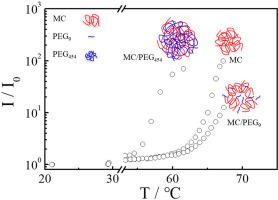Polymer ( IF 4.1 ) Pub Date : 2022-11-14 , DOI: 10.1016/j.polymer.2022.125510 Zhengli Peng , Mo Zhu , Jinxian Yang , Lianwei Li

|
In this study, by using a set of narrowly distributed polyethylene glycol (PEG) samples with varied average molar mass (PEGn, 9 < n < 454), we have systematically studied how PEG molar mass and solution concentration influence the thermal response behavior of methyl cellulose (MC) aqueous solutions (Mw = 4.3 × 105 g/mol, <Rg> = 71 nm) by a combination of isothermal titration calorimetry (ITC), rheometer, UV–vis spectroscopy, laser light scattering (LLS) and atomic force microscopy (AFM). At room temperature, ITC result clarifies the existence of extremely weak hydrophobic interactions between MC and PEG chains. In addition, for MC/PEG mixed solution with shorter PEGs (PEG22 and PEG90), experimentally measured zero-shear viscosity (ηexp) is confirmed to be 5–10% higher than the theoretical values (ηcalc), further supporting the interchain association. Whereas for MC/PEG454, insoluble aggregates are formed, which results in ηexp < ηcalc. Further, dynamic laser scattering (DLS) results further reveal how the percentage of peak area of aggregates depends on the chain length of PEG. During the heating process from T = 20 to 70 °C, a combination of UV, LLS and AFM results clearly illustrates that the shorter PEG chains can effectively stabilize the formed MC fibers and prevent the fiber extension; whereas for longer PEG chains, they can not only promote the nucleation process, but also destabilize the formed fibers and promote the fiber extension. Our result unambiguously reveals the macromolecular effect of PEGs on the thermal response behavior of MC in solutions.
中文翻译:

不同链长的聚乙二醇如何影响甲基纤维素在水溶液中的热响应行为?
在这项研究中,通过使用一组具有不同平均摩尔质量(PEG n,9 < n < 454)的窄分布聚乙二醇(PEG)样品 ,我们系统地研究了 PEG 摩尔质量和溶液浓度如何影响热响应行为甲基纤维素 (MC) 水溶液 ( M w = 4.3 × 10 5 g/mol, < R g > = 71 nm) 通过等温滴定量热法 (ITC)、流变仪、紫外-可见光谱、激光散射 (LLS) ) 和原子力显微镜 (AFM)。在室温下,ITC 结果阐明了 MC 和 PEG 链之间存在极弱的疏水相互作用。此外,对于具有较短 PEG 的 MC/PEG 混合溶液(PEG22和 PEG 90),实验测量的零剪切粘度 (η exp ) 被证实比理论值 (η calc ) 高 5-10%,进一步支持链间缔合。而对于 MC/PEG 454,会形成不溶性聚集体,这会导致 η exp < η calc。此外,动态激光散射 (DLS) 结果进一步揭示了聚集体的峰面积百分比如何取决于 PEG 的链长。在从T的加热过程中 = 20 至 70 °C,结合 UV、LLS 和 AFM 结果清楚地表明,较短的 PEG 链可以有效地稳定形成的 MC 纤维并防止纤维延伸;而对于较长的 PEG 链,它们不仅可以促进成核过程,还可以使形成的纤维不稳定并促进纤维延伸。我们的结果明确揭示了 PEG 对 MC 在溶液中的热响应行为的大分子效应。











































 京公网安备 11010802027423号
京公网安备 11010802027423号